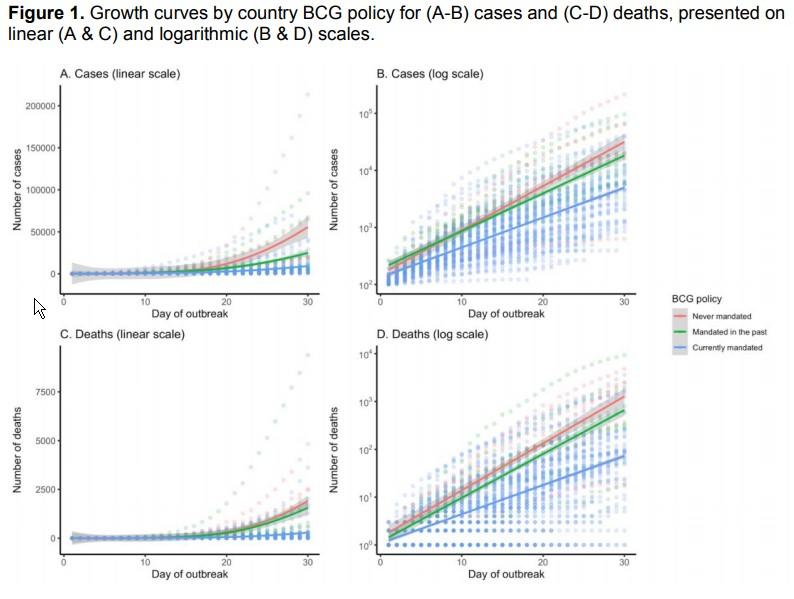The Bacille Calmette-Guérin (BCG) vaccine induces epigenetic reprogramming in human monocytes in vivo, followed by functional reprogramming and protection against non-related viral infections, with a key role for IL-1β as a mediator of trained immunity responses (1). However, any impact of BCG immunization on COVID-19 specifically is unknown.
At this time, there is some evidence that the BCG vaccine helps to protect us against the COVID-19 viral infections. However, the studies that show this do not have sound validity at this time due to them being pre-print, with no peer review. Because of this, it is recommended to follow the WHO guidance of not using the BCG vaccination for the prevention of COVID-19 until there is further data available through controlled clinical trials (3).
 = Supporting use article = Supporting use article |
 = Neutral Article = Neutral Article |
 = Contradicting use article = Contradicting use article |

 |
 |
 |
   |
 |
 |
Clinical Information
 Observational SARS CoV-2
Observational SARS CoV-2
 Miller A, Reandelar M, Fasciglione K, et al.
Miller A, Reandelar M, Fasciglione K, et al.
- Title: Correlation between universal BCG vaccination policy and reduced morbidity and mortality for COVID-19: an epidemiological study. (https://www.medrxiv.org/content/10.1101/2020.03.24.20042937v1)
- Study Details:
- Collection of BCG vaccination policies across countries from a BCG World Atlas (found at http://www.bcgatlas.org/) for countries with populations >1 million, along with data of COVID-19 cases and deaths per country (found at https://google.org/crisisresponse/covid19-map) as of 3/21/20 AM.
- Results (see table and figure below):
- Countries were divided in 3 categories: low income (annual income of 1025 dollars or less), lower middle income (annual income of 1026-3995 dollars), and middle high and high income countries (annual income greater than 3996 dollars)
| Country Classification | Deaths per Million (mean+SEM) | Cases per Million (mean+SEM) | Other Info |
|---|---|---|---|
| Low Income with Current Universal BCG policy (18 countries) | Not provided | 0.32±0.09 | 17/18 countries reported 0 deaths - thought to be related to underreporting, which led to data being excluded from analysis |
| Middle High and High-Income with Current Universal BCG policy (55 countries) | 0.78 ±0.40 | 59.54±23.29 | Some variability found with mortality rate (increased lethality with age) |
| Middle High and High-Income with No BCG policy (5 countries) | 16.39±7.33 | 264.90±134.88 |
Conclusions:
- This epidemiological study shows that there are some differences in morbidity and mortality produced by COVID-19 across different countries, which could be linked to BCG vaccination policies.
- Researchers thought that the earlier a country implemented a BCG policy, the stronger the reduction in COVID-19 related cases, morbidity and mortality
 Berg M, Yu Q, Salvador C, et al.
Berg M, Yu Q, Salvador C, et al.
- Title: Mandated Bacillus Calmette-Guérin (BCG) vaccination predicts flattened curves for the spread of COVID-19
- Study Details: Examination of day-by-day reports of confirmed cases and deaths, along with analysis of growth curves in countries with mandated BCG policies vs those without. The start of the growth curve (which illustrated the process of viral spread in each country) was set to start on the same day for each country. Focus was placed on a time period either after the first 100 confirmed cases in the country or after one confirmed COVID-caused death. Analysis was limited to the first 30 days of onset of country-wide outbreaks.
- Results:
- COVID-19 Cases
- The growth rate of COVID-19 cases was significantly slower in countries with mandated BCG vaccinations, compared to countries without mandated BCG vaccinations, b = -0.027 (p < 0.001) (noted that “cultural dimensions of individualism vs collectivism, power distance, and tightness/looseness” were not accounted for).
- Countries that once had such policies but terminated them before 2000 were not significantly different in growth rate from those that never instituted mandatory BCG vaccinations, b = - 0.006 (p = 0.440).
- COVID-19 Deaths
- The growth rate of COVID-19 related deaths was significantly less in countries with mandated BCG vaccinations, compared to countries without mandated BCG vaccinations, b = -0.038 (p < 0.001).
- Countries that once had such policies but terminated them before 2000 were no different in growth rate from those that never instituted mandatory BCG, b = -0.003 (p = 0.829).
- COVID-19 Cases
- Conclusions:
- This analysis shows that BCG policies could be associated with a “flattening of the curve” in the spread of COVID-19. However, it is felt that there is an urgent need for randomized clinical trials regarding the BCG vaccine and COVID-19.
- Researchers feel that the BCG vaccination may become effective only when a large portion of the population becomes resistant to the virus (i.e. when herd immunity is acquired) due to growth curves in countries with implementation of BCG vaccination policies in the 20th century having similar growth curves to those with no policy.
- Researcher noted limitations:
- Possible unreliability in reporting due to factors such as diagnostic test availability
- Unclear data about the effectiveness of the BCG vaccination when given to adults, how long it may provide immunity for COVID-19, or potential adverse effects if the vaccine is given to a patient already infected with COVID-19
- The analysis only focuses on the first 30 days of the initial outbreak in countries, regardless of country coping strategies such as stay-at-home orders
- Substantial variation across countries with mandated BCG vaccine policies seen on growth curves
- There was little to no consideration for other factors that could account for the found differences such as demographic differences in countries, disease burden, testing rates for COVID-19 virus infections, and the stage of the pandemic in each country (3)
- The following disclaimer preceded the study: “This article is a preprint and has not been peer-reviewed. It reports new medical research that has yet to be evaluated and so should not be used to guide clinical practice.”
References
- Arts RJW, Moorlag SJCFM, Novakovic B, et al. BCG Vaccination Protects against Experimental Viral Infection in Humans through the Induction of Cytokines Associated with Trained Immunity. Cell Host Microbe. 2018;23(1):89-100.e5.
- Miller, Aaron & Reandelar, Mac & Fasciglione, Kimberly & Roumenova, Violeta & Li, Yan & Otazu, Gonzalo. (2020). Correlation between universal BCG vaccination policy and reduced morbidity and mortality for COVID-19: an epidemiological study.
- “Bacille Calmette-Guérin (BCG) Vaccination and COVID-19.” World Health Organization, World Health Organization,
- Berg, M., Yu, Q., Salvador, C., Melani, I., & Kitayama, S. (2020). Mandated Bacillus CalmetteGuérin (BCG) vaccination predicts flattened curves for the spread of COVID-19.
